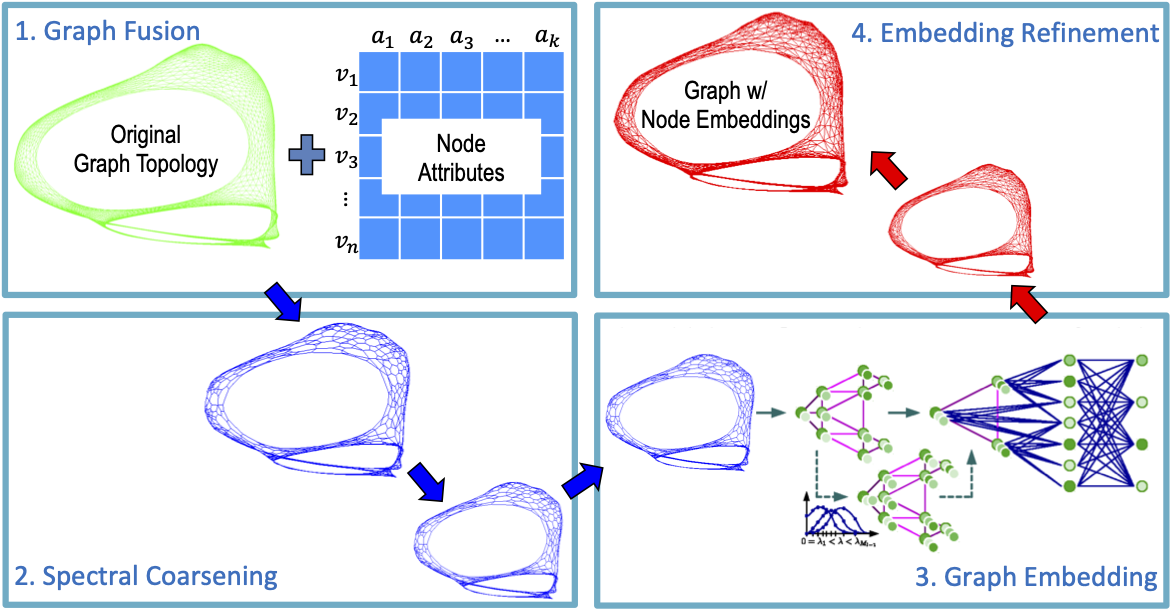GraphZoom is a framework that aims to improve both performance and scalability of graph embedding techniques. As shown in the following figure, GraphZoom consists of 4 kernels: Graph Fusion, Spectral Coarsening, Graph Embedding, and Embedding Refinement. GraphZoom More details are available in our paper: https://openreview.net/forum?id=r1lGO0EKDH
If you use GraphZoom in your research, please cite our preliminary work published in ICLR'20.
@inproceedings{deng2020graphzoom,
title={GraphZoom: A Multi-level Spectral Approach for Accurate and Scalable Graph Embedding},
author={Chenhui Deng and Zhiqiang Zhao and Yongyu Wang and Zhiru Zhang and Zhuo Feng},
booktitle={International Conference on Learning Representations},
year={2020},
url={https://openreview.net/forum?id=r1lGO0EKDH}
}
- lamg-based coarsening: This is the spectral coarsening algorithm used in the original paper, but it requires you to download Matlab Compiler Runtime (MCR).
- simple coarsening: This is a simpler spectral coarsening implemented via python and you do not need to download MCR. This algorithm adopts a similar idea to coarsen the graph (spectrum-preserving), while it may compromise the performance compared to lamg-based coarsening (especially for run-time speedup).
- Matlab Compiler Runtime (MCR) 2018a(Linux), which is a standalone set of shared libraries that enables the execution of compiled MATLAB applications and does not require license to install (only required if you run lamg-based coarsening).
- python 3.5/3.6/3.7 (We suggest Conda to manage package dependencies.)
- numpy
- networkx
- scipy
- scikit-learn
- gensim, only required by deepwalk, node2vec
- tensorflow, only required by graphsage
- torch, ogb, pytorch_geometric, only required by Open Graph Benchmark (OGB) examples
- install matlab compiler runtime 2018a(Linux) (only required if you run lamg-based coarsening)
1. wget https://ssd.mathworks.com/supportfiles/downloads/R2018a/deployment_files/R2018a/installers/glnxa64/MCR_R2018a_glnxa64_installer.zip`
2. unzip MCR_R2018a_glnxa64_installer.zip -d YOUR_SAVE_PATH
3. cd YOUR_SAVE_PATH
4. ./install -mode silent -agreeToLicense yes -destinationFolder YOUR_MCR_PATH
- install PyTorch Geometric (only required if you run OGB examples)
- create virtual environment (skip if you do not want)
1. conda create -n graphzoom python=3.6
2. conda activate graphzoom
- install packages for graphzoom
pip install -r requirements.txt
GraphZoom/
│ README.md
│ requirements.txt
│ ...
│
└───graphzoom/
│ │ graphzoom.py
│ │ cora.sh
│ │ ...
│ │
│ └───dataset/
│ │ │ cora
│ │ │ citeseer
│ │ │ pubmed
│ │
│ └───embed_methods/
│ │ DeepWalk
│ │ node2vec
│ │ GraphSAGE
│
└───mat_coarsen/
│ │ make.m
│ │ LamgSetup.m
│ │ ...
│
└───ogb/
│ │ ...
│ └───ogbn-arxiv/
│ │ │ main.py
│ │ │ mlp.py
│ │ │ arxiv.sh
│ │ │ ...
│ │
│ └───ogbn-products/
│ │ main.py
│ │ mlp.py
│ │ products.sh
│ │ ...
│
Note: If you run lamg-based coarsening, you have to pass the root directory of matlab compiler runtime to the argument--mcr_dir when running graphzoom.py
Example Usage
-
cd graphzoom -
python graphzoom.py --mcr_dir YOUR_MCR_PATH --dataset citeseer --search_ratio 12 --num_neighs 10 --embed_method deepwalk --coarse lamg
--coarse: choose a specific algorithm for coarsening, [lamg, simple]
--reduce_ratio: the reduction ratio when choosing lamg-based coarsening method
--level: the coarsening level when choosing simple coarsening method
--mcr_dir: root directory of matlab compiler runtime
--dataset: input dataset, currently supports "json" format
--embed_method: choose a specific basic embedding algorithm
--search_ratio: control the search space of graph fusion
--num_neighs: control number of edges in feature graph
Full Command List
The full list of command line options is available with python graphzoom.py --help
You can easily plug a new unsupervised graph embedding model into GraphZoom, just implement a new function, which takes a graph as input and outputs an embedding matrix, in graphzoom/embed_methods.
The current version of GraphZoom can support the following basic models:
- DeepWalk
- node2vec
- GraphSAGE
- Cora
- Citeseer
- Pubmed
You can add your own dataset following the json format in graphzoom/dataset
Here we evaluate GraphZoom on Cora dataset with DeepWalk as basic embedding model, with lamg-based coarsening method. GraphZoom-i denotes applying GraphZoom with i-th coarsening level.
| Method | Accuracy | Speedup | Graph_Size |
|---|---|---|---|
| DeepWalk | 71.4 | 1x | 2708 |
| GraphZoom-1 | 76.9 | 2.5x | 1169 |
| GraphZoom-2 | 77.3 | 6.3x | 519 |
| GraphZoom-3 | 75.1 | 40.8x | 218 |
We also evaluate Graphzoom on ogbn-arxiv and ogbn-products dataset with lamg-based coarsening method, and GraphZoom-1 has better performance and much fewer parameters than the Node2vec baseline.
ogbn-arxiv
| Method | Accuracy | #Params |
|---|---|---|
| Node2vec | 70.07 ± 0.13 | 21,818,792 |
| GraphZoom-1 | 71.18 ± 0.18 | 8,963,624 |
ogbn-products
| Method | Accuracy | #Params |
|---|---|---|
| Node2vec | 72.49 ± 0.10 | 313,612,207 |
| GraphZoom-1 | 74.06 ± 0.26 | 120,251,183 |
The matlab version of lamg-based spectral coarsening code is available in mat_coarsen/
